
Since I’ve pushed it off the first page, here’s a direct link to the current podcast, or see them all by clicking Video Podcasts at right.
 |
|


Since I’ve pushed it off the first page, here’s a direct link to the current podcast, or see them all by clicking Video Podcasts at right.
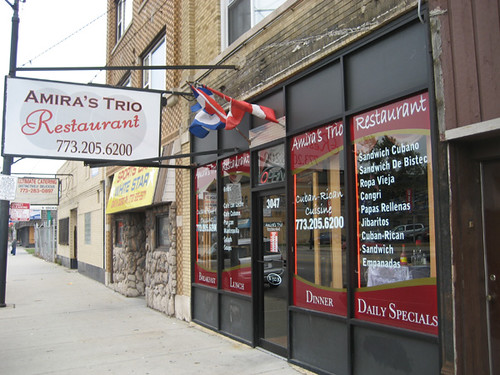
For my latest restaurant-not-widely-talked-about-on-LTHForum-or-anywhere-else, I was going to write about Amira’s Trio, a Cuban-Puerto Rican spot on Cicero a little north (on the other side of the street) of Sol de Mexico. But there was enough personality and pizazz in this little but attractive and friendly spot, especially given its owner, Vicky Amira, that I saw a chance to sell a piece on it— and so it appears this week in Time Out Chicago’s Save This Restaurant column.
So read it there, and then, believe me, you won’t regret a visit to Amira’s Trio, the archetypal welcoming family-run restaurant, clean and neat enough that you can even take people who don’t share your taste for ethnic dives, as long as they love good, hearty comfort food— and being fussed over by a warm, maternal owner.
Amira’s Trio
3047 N Cicero Ave.
773-205-6200
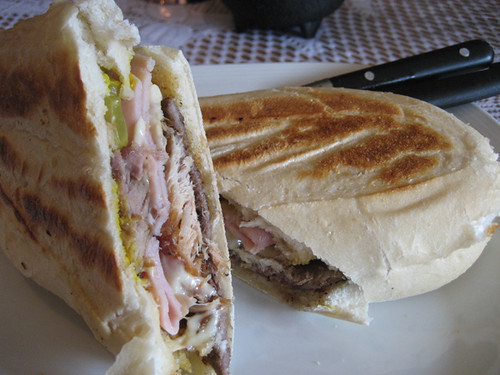
The Cuban-Rican, half Cubano, half Jibarito.
To see more in this series, click Restaurant Reviews at right and look for the numbered reviews.
Tags: amira's trio, cuban, puerto rican, sol de mexico, time outI made lardo, seasoned cured pig fat once. (You can see how here.) It was okay. I still have some vacu-packed in my freezer. It really only works as a novelty for parties; you don’t get very far with a spouse saying “Some pigfat for your bread, darling?”
Taken in very small moderation, sliced super-thin and placed on a piece of just-toasted bread that it melts into, it’s a wonderfully decadent thing. Still, my one adventure in lardomaking might have been my only, except that during the production of my current Sky Full of Bacon podcast, starring Rob Vital Information Gardner’s pig head, Rob also gave me the back fat from his hog. It sat in my freezer for a month with no particular end use in mind.
That changed with a conjunction of recent events. One was tasting the house-cured lardo at Vie last Friday. Although Mike Sula and I both found it a little too sweet for our tastes, overall the complexity and lushness of the thinly sliced fat inspired me to want to give lardomaking another shot.
The other was acquiring Jennifer McLagan’s new cookbook Fat. Having admired her book Bones, I even more admired the unabashed attitude behind a book that boldly proclaims:

On pp. 95-6, she gives a much more detailed explanation of where lardo originates than I’d read before:
The method for making lardo has changed little over time. It begins with back fat, usually with the skin still attached, which is cut into thick rectangular slabs. These pieces of fat are rubbed with a spiced sea salt mixture containing black pepper, fresh rosemary and garlic. Each producer adds his own special blend of spices, which can include cloves, cinnamon, coriander, nutmeg, juniper, bay leaves, sage, oregano, thyme and star anise. Once seasoned, the fat is packed into rectangular marble vats called concas. These concas are placed in cellars where the fat ages for six months to two years. During this time the salt draws the moisture from the fat, forming a brine that preserves it, while the combination of spices and herbs adds flavor…
The best-known lardo is lardo di Colonnata, made in Colonnata, a tiny Tuscan town perched in the hulls above the marble quarries of Carrara… The quarries still provide the marble for the local concas, and some producers claim that it is the porous quality of this marble that is the key to the finesse of lardo di Colonnata…
Now, I had my doubts about some of this— for instance, that enough liquid will ever come out of the fat to produce this brine. Nevertheless, now I had a certain model to follow. So I trimmed out the fat, unfortunately it had been cut rather randomly already, but I produced a reasonable assortment of pieces which would fill a square foot:
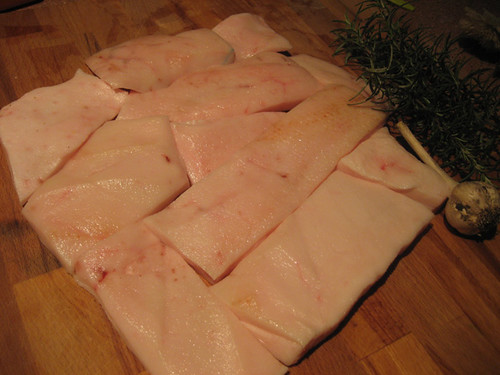
I went to Home Depot and found two large marble tiles, and to the Container Store to find a box of the right size. Since the box wasn’t food grade, I lined it with parchment paper. If it gets to the point where enough liquid is expressed, I can figure something else out, but for now that seemed fine. I made my spice blend: a lot of sea salt, some black pepper, toasted coriander and juniper, plus ground garlic and rosemary shredded in the food processor. I placed the first marble tile in the box, covered it with a layer of the spices, arranged the pieces tightly together, and packed more spice over them and in all the little crevices:
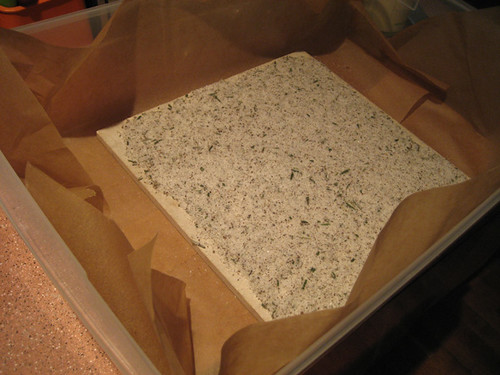
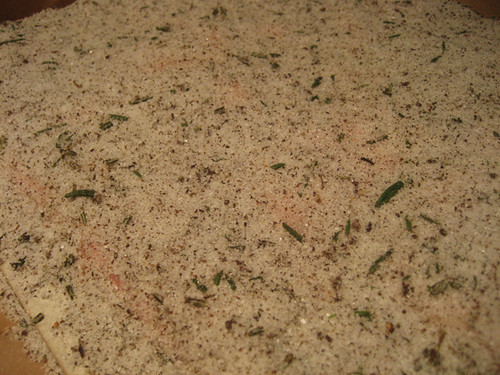
Finally, I lay the other marble tile on top, and then weighted it down further with some old leftover tiles, which won’t touch food.

Then into the bottom of the beer fridge for the next six months— or more. Check back in April to find out how it turned out!
UPDATE 11/22/08: I started to get nervous about not having any pink salt in my lardo salt mix to ward off the nastiest bugs like Clostridium botulinum. So since I had to move the lardo out of the fridge and into a nearly-as-cold cellar to make room for a thawing T-day turkey, I took the opportunity to scrape a lot of the salt back into a bowl, mix it with an appropriate amount of curing salt, and repack the lardo. A little of the salt around the edges had become crusty, suggesting that a little bit of moisture has been expressed over time, but as expected it’s nowhere near what the bacon does in just a few days. Does that mean it will absorb the pink salt, if there’s no liquid to facilitate osmosis? We shall see in another 4-1/2 months…
Tags: backfat, Charcuterie, curing, fat, jennifer mclagan, lardoWith the 800-lb. gorilla of Chicago restaurant cookbooks just hitting stores and an exquisitely rarefied seafood tasting menu earning the title of best new restaurant in America, it’s easy to see ours as a restaurant scene dominated by artifice, weird science, and great-brain chefs. But I think last night’s mulefoot pig dinner, initiated by the Reader as part of Mike Sula’s writings about this heritage breed and planned by Paul Kahan at Blackbird with the aid of five other chefs, ought to stand as an equally momentous occasion— the moment when a movement devoted to cooking rooted in the flavors of midwestern products reached a critical mass and a level of comprehensive achievement that needs no excuses or significant ringers from outside to make a good meal. Obviously there have been restaurants cooking midwestern products for a long time, and given that four of the chefs came from within Kahan’s company and a fifth was a longtime employee who went off on his own, you could argue how widespread the movement is on our scene— but on the other hand, given that those restaurants represent a pretty significant chunk of the most-admired restaurants in town, if they have a movement, there’s a movement.
More significant to me, and on a practical basis, isn’t the names of the chefs involved but of the farmers whose names I kept hearing as Mike Sula and I followed the progress of the dinner.* Gunthorp, Green Acres, Rasmussen, Nichols— this is where the critical mass has been reached, that the chefs support the quality farmers enough to keep them going, and the quality farmers produce consistently enough to keep the chefs supplied and satisfied with the level of their product. What we saw last night was that given a great ingredient— the clean, lushly fatty meat of the mulefoot pig— as a focus for the meal, these six chefs (actually more across all six restaurants) could produce a coherent meal reflective of a similar approach to showcasing the inherent flavors of the midwest’s products at their most heightened and refined, without artifice or gilded pork-lilies, but with plenty of good midwestern stuff like bacon or pickled onions.
And by “coherent” I mean “spectacularly good.” Around me I heard comments like “I feel like I’ve never tasted pork before,” and that more than once in relation to different dishes. The chefs had divvied up the meat to give different chefs different opportunities and places to focus, and so each course brought us a different view of what pork, that “wonderful, magical animal,” could be, from the organy funk of Vie’s cotechino (not as organy-funky as hoped, thanks to the USDA inspector flunking most of the offal at the processor, alas), to the simple clean flavor of a ham chop from Blackbird’s Mike Sheerin. For me there were two particular standouts: Vie’s cotechino, salty and strong, but leavened by the sweet note of a pickled plum, and the headcheese ravioli in a pork consomme from Avec’s Justin Large, the broth a marvelous, slightly lemony shot of concentrated pork savoriness. But there was revelation throughout the meal— I heard others say they were blown away by Lula’s pork belly, amazed at how delectable a cube of almost pure fat could be, or by the snow-white pork rinds that made up part of Blackbird’s cheese course, or the deeply comfy rosemary-scented roast-pork satisfaction of The Publican’s porchetta.
There was one spectacular dud, not a course but a wine pairing— an Indian (!) sirah which, evoking comparisons like “burnt soup” and “V-8 juice,” did not suggest that India will be replacing Chile or Australia just yet. But otherwise wine pairings (and in The Publican’s case, Goose Island Harvest Ale) were well-chosen and enjoyable, service was impeccable at a level of crowding even beyond the likely norm for Blackbird, and all in all, it was a wonderful, magical dinner, basking in the waves of enjoyment which outstanding pork provided, and knowing that just a few seats away were, for once, the farmers who had made our exquisite cityfied pleasures possible. Tremendous thanks to them and to Paul Kahan and all his team for creating an occasion which showcased and honored them and their contributions in so spectacular a fashion (and not least of the heartening aspects of the meal was getting to watch such a bunch of heavyhitters in the kitchen working together side by side and without ego).
* He will post reports on the Reader’s Food Chain blog, and eventually have a lengthy piece in the Reader, while I’ll have a Sky Full of Bacon podcast about the event at the same time.
Tags: avec, blackbird, chicago reader, lula, mulefoot pig, pork, the publican, the reader, vieA secret menu at Vie? What would that be, stuff they flew around the globe in the middle of winter to eat?
No, there’s no secret menu but there is one off-menu item that you might want to check out, available only in a very small quantity on Friday nights: a burger. Yeah, so? you ask. Well, it’s a burger that right now is being made from bits of the whole steer they dry-aged at Eickman’s in Seward, Illinois and butchered themselves.
Accompanied by fries fried in the tallow from the same or at least similar beasts, this is very much a Vie-style burger, the pure, dry-aged-beefy flavor of the meat front and center with only minimal accompaniments: some pickled onions and ramps and a ketchup made in house from some of the small sweetish tomatoes that were in the markets a few weeks ago. Frankly, given the sweetness of the ketchup, I’d have liked the meat more salted and seasoned for contrast, but that’s a minor cavil, the flavor of the high quality beef is what counts and it was terrific. The fries as dipped in that ketchup were mighty fine, too.
It was also my first time having the Vie salad, a simple but outstanding mix of greens with two kinds of hearts of palm— marinated chunks, like you remember from country club dining circa 1967, and shaved slices of fresh hearts of palm, nearly three inches across and more like daikon or something than canned HoP, all set off— or I should really say, all made— by shaved parmesan which just burst with bright and deep cheese flavor. Really, the best composed salad I’ve had in a restaurant in as long as I can remember, and I wasn’t surprised when Paul Virant told us that they keep trying to take it off the menu and replace it, but they can never seem to beat it, and so it’s lasted two years.
Finally, I talked for a bit with Nathan Sears, Vie’s sous and the charcuterie guy, about lardo, my own attempt at lardo-making having been somewhat less than satisfying. He brought out a few slices of theirs, which I found a little sweet— it comes from a pig called a Crawford Sweet, and they use sugar in the cure— but melted in the mouth giving off a complex mix of herbal and porky flavors. I am newly inspired, and may use the winter to attempt another go-round at lardoblogging myself.
Vie
4471 Lawn Ave.
Western Springs, IL 60558
708-246-2082
The craziness referred to in my previous post is this: I am shooting the steps leading up to the dinner at Blackbird on Sunday night where three mulefoot pigs, acquired by the Chicago Reader— no, not as part of the Creative Loafing deal, but in relation to the series of stories Mike Sula wrote about this rare breed— will be served to a bunch of people paying $150 $125 a plate and benefitting Slow Food.
What this has meant is, on Tuesday we drove up to Argyle, Wisconsin, a little southwest of Madison, met the farmers involved, and then helped load three pigs into a crate on the back of a pickup truck, a feat of slapstick comedy which the Three Stooges could not have done better at, and drove them to Eickman’s, a processor in Seward, Illinois, to spend their last night on this earth.
Wednesday we were met at Eickman’s by Jason Hammel, chef at Lula, and watched the slaughter process. I was not allowed to film the moment of killing, which I’m not entirely sorry about, but believe me, I could make a plenty gory video out of what I did get. However, the point is not to be shocking, but to deal honestly with the fact that not only do creatures die to provide meat for us, but breeds like the mulefoot won’t survive unless there’s a market for them and farmers willing to raise them as a business.
Wednesday Jason drove back with three iced pigs in a pickup truck and we delivered them to the side door of Blackbird, just as people in nice clothes were arriving at the front for dinner. If anyone bothered to look down the alley, they should have had a perfect view of Hammel and Blackbird chef Mike Sheerin hoisting the fat pink pigs up into the freight elevator, like Scorsese characters preparing to dispose of a fellow mobster. We returned around 11 as Hammel, Sheerin, Paul Kahan, and Paul Virant of Vie arrived for a late night butchering party. Afterwards we went to the hot new Kahan place, The Publican, for Belgian beers after its closing hours; I’m sure we’ll be among the few ever to see it empty. Or among the few to do so after having hacked three whole hogs into sections.
Today we’re visiting The Publican and Vie to see what they’re doing with their sections, and will hopefully do the same at Lula tomorrow. Then Sunday I’ll get to shoot at least some part of the service, though I have no intention of being the annoying guy on the floor with a camcorder.
The challenge in all this will be that the slaughter section, no matter how tasteful and rationally presented, is bound to be uncomfortable— and to make everything else done with the meat seem barbaric. We’re all so far from where our meat comes from that, like good Germans, we’ve successfully put the machinery of death out of mind and can pretend that it has nothing to do with us. Seeing slaughter didn’t make an instant vegetarian out of me, but what I hope it has done is make me a little less of a hypocrite about the meat I eat. If I’m going to demand an animal’s death, I should demand a decent life for it as well. Industrial food is very good at keeping unpleasant ways of raising animals out of sight of most of us who eat them; this video— or videos if it gets split into two parts— will be about confronting that and the challenge of making it humane.
Oh, and about some really great Chicago chefs making fantastic food. You see why it almost has to be in two parts, as there’s way more than just one simple subject here….
Today was one of those days where you’re doing ten million crazy things, those of you who watch the next Sky Full of Bacon will see just how crazy, so when I got home from them and my wife had wound up stuck with the duty of picking up the kids in Rogers Park and the dog in West Town, I figured the least I could do was cook dinner.
I remembered something I had been importuned into by my youngest son. We’d gone to Trader Joe’s a week ago, and they were giving out samples of, well, let’s call them Trader Giotto’s Nouvelle Spaghetti-Os. Take a 32 oz. box of TJ tomato soup, a couple of tablespoons of TJ pumpkin butter, and a couple of cups of TJ pasta in an O-ring shape. Boil pasta, heat soup with pumpkin butter, dash with soy sauce (Trader Jao’s?), drain pasta, dump into soup mixture, let absorb soup, and in not much time… instant dinner. So I bought the ingredients, fully recognizing that I was taking a step into the kind of mix-three-packaged-products cooking that I loathe and, understandably, associate with the worst cooking show in the history of mankind, Semi-Homemade With Sandra Lee. I hated myself for doing it, but I knew the night would come when it would be handy and make a kid or two happy.
And so it came and I made it. To be honest, it wasn’t bad– too sweet, as you might expect (some recommended parmesan helped there), but at least of some interest, I didn’t mind it a bit. In fact, it made me want to sing a song, a la Mad magazine (*Sung to the tune of “Sandra Dee”):
Look at me, I’m Sandra Lee
Lousy culinarily,
Won’t cook a meal ‘less it comes with a seal
To open, Sandra Lee
Taste it! Hey, I’m Rachel Ray
Eating on forty dollars a day
I’ll double yum a sauteed chewing gum
Oh my God, I’m Rachel Ray*
So are you concerned that I’ve gone over to the dark side? Ironically, at the very moment I was being a kitchen ho and making my family dinner out of jars, bags and Tetra-Paks, I was engaged in the most diametric opposite kitchen activity I can imagine. Well, okay, maybe not THE most, I hadn’t nailed an eel to a board to skin it, but close enough. A pair of pork bellies had just arrived from my friends at Northeast Iowa Specialty Meats, and so once I had the Trader Joe pumpkin butter cooking in the Trader Joe tomato soup, I turned my attention for a moment to pouring pre-mixed (by me) cure into the bags with the bellies, adding some maple syrup and smooshed juniper berries, and sealing them up to cure in the beer fridge for the next 10 days or so. Semi-Ho dinner, but homemade bacon. We all find ourselves with such culinary split personalities from time to time….
Tags: rachel ray, sandra lee, semi-ho, semi-homemade, trader joe's
UPDATE 5: Some more thanks for the linkage to Chicago Examiner, who writes a whole piece about the underlying use-the-whole-pig issues which is well worth reading.
UPDATE 4: Well, I’m busy filming more pig action for the next video, so all I can do here is continue to thank folks for more nice words and links. Today’s are a site called SlimPickinsPork, and this very kind comment at Chow.com from Chicago’s own Nicholas Day:
America, 2008: A land where people are filming, editing, and posting a professional-quality internet film about buying and cooking a pig’s head. A 19-minute film about buying and cooking a pig’s head. From the splendidly named Chicago food site Sky Full of Bacon, the video follows a pig’s head from the Oak Park farmers’ market to the farm-to-table restaurant Mado where it’s made into testa (recipe included). Highly recommended, but if you want to get straight to the headcheese, skip to the eight-minute mark.
UPDATE 3: The great Michael Ruhlman kindly linked to the headcheese video here.
Whether you got here from Menu Pages thanks to the Special Guest Headcheese Taster, or the Springfield Journal-Register thanks to my aversion to horseshoes, welcome. UPDATE: Thanks for links also to Mike Sula and Vital Info, and check it out at the Local Beet too. UPDATE 2: Thanks to Chuck at Chicagoist and Andrew at Gaper’s Block, and hey, this is kind of funny.
Check out the latest podcast directly below, or click here to read the original Springfield post.
One of the dangers of being a blogger somewhat dependent for publicity and awareness on bigger fish is that when you say anything about bigger media, you look like you’re sucking up. Most notably, to yourself.
Nevertheless, at the risk of appearing to be taking the brimstone-scented gelt of Zell himself, I have to say, the Tribune food section has really kicked some butt lately. Although the section is often identified with its star reviewer, Phil Vettel, I have to admit that’s not the part I pay attention to, so I have no position on whether he’s getting unusually soft on high-end restaurants, or just usually soft. Hot new restaurant reviews are for people who need to show off where they’ve been to, not people who care about food.
What’s interesting is that the stuff beyond the starred reviews that is for people who care about food has really been good lately. In fact I can’t help but think that there is a mandate to let the Tribune writers escape the shackles of the institutional voice and write with more of a personal, blog-like spin– but on the kinds of topics, and with the kinds of resources, that we associate with newspapers and good reporting. When that approach works, it really is the best of both worlds, and the Trib food section has made it work several times lately:
• Christopher Borrelli wrote a great character sketch of a breakfast obsessive, sympathetic and yet also not afraid to portray the guy as kind of wacky.
• Monica Eng chronicled her visits to various places where animals are killed and her reactions to it– the kind of personal writing that wouldn’t have been in a newspaper pre-blog, but with a length and breadth that few bloggers could have devoted the resources necessary to achieve.
• The newly-redesigned Trib did a lavish how-did-Columbus-affect-food section for Columbus Day. Not all of it was great, there are some term-paper-cribbed-out-of-the-Brittanica* pieces in it, but several are well worth checking out such as Emily Nunn on pecans and Bill Daley’s video tour of a post-Columbian produce section.
• Monica Eng again with a good version of an oldie but goodie, reporter follows health inspectors on their rounds.
So, count me today as someone who doesn’t think the American newspaper is dead yet. Actually, I think the Trib’s food section has started making the right move from being for the person who’s just barely interested in food (and will look at the Jewel ads) to the person who’s quite interested in it and wants quality coverage. So what’s the bad news for the Tribune, since there must be some?
The bad news is, I didn’t find any of these stories via the main chicagotribune.com. I first heard about them somewhere else— Menu Pages’ blog or the Trib’s own The Stew or Ronnie Suburban’s media roundup on LTHForum or whatever. In fact, even when I knew about them and wanted to find them via the Trib site, it was usually difficult (note that Menu Pages also gave up on trying to embed the Daley produce section video, which puts Sky Full of Bacon one technological step ahead of the mighty TribCo). How people who know how to create a visually coherent special section in print can only produce a hopeless jumble online is beyond me, but the first thing standing in the way of the American newspaper online is the messy, visually unappealing, confusing as hell American newspaper website.
There, Sam, keep your damn gelt and use it to make your site work, like the New York Times’ but almost no other paper’s does.
*Deliberately archaic reference
Tags: bill daley, chicago tribune, christopher borrelli, monica eng, newspapersSo a few installments of my “restaurants that haven’t been talked about on LTHForum or all that much anywhere else” ago, I wrote about Al-Basha, a middle eastern restaurant in a south suburban strip mall where I found that a menu of familiar favorites was distinguished by unusually fresh and bright flavors, ranking among the best of such things as shawerma, falafel and baba ghanoush that I’ve had lately.
Today, in a change of pace, I present Al Bawadi Mediterranean Grill, a middle eastern restaurant in a south suburban strip mall where I found that a menu of familiar favorites was distinguished by unusually fresh and bright flavors, ranking among the best of such things as shawerma, falafel and baba ghanoush that I’ve had lately.
Actually, credit for finding this one goes to my wife. Yes, I was the one who put us on 87th heading toward Harlem to look for middle eastern, but she was the one who spotted Al Bawadi’s sign and most critically, its promise of “Natural Fire Wood Grilled” meats, and fought her way through vicious traffic to land us in its parking lot.
Al Bawadi is located in a former fast food building, which they are in the process of expanding so that they can have a nonsmoking original building and a separate hookah room. The building looked vaguely Alamo-like, but I couldn’t quite place it, so after our meal I asked our waiter if it had been a Mexican restaurant. He clearly thought I was asking if the meal we had eaten was Mexican food, and, eyes bulging in disbelief and dismay, carefully explained to the astonishingly stupid gringo (who somehow knew baba ghanoush and falafel by name, but apparently believed them to be salsa and chips), that the restaurant was Jordanian-Palestinian. Eventually I got out of him that the building had once been an Arby’s, but I’m not sure I ever convinced him that I hadn’t mistaken his place for Senor Sombrero’s.
It is, let me say, a vast improvement, not only because of the much more pasha-decadent decor (I assume the paisley curtains and pillows are not Arby’s originals) but because the food was simply first-rate throughout. Again, it’s not that anything was anything all that unusual— fattoush salad, hummus and baba ghanoush, falafel, a mixed grill platter with shawerma and kebabs— but it was all really well executed, bright spices, fresh as could be, chicken kebab perfectly cooked and so on. (There are some grilled fish dishes and the like that seem a little beyond the usual.) The only item I hadn’t really seen before was a freebie on the plate of nosh set on our table as we arrived; along with the usual pickled vegetables and some toasted pita, we got a pile of smooshed eggplant mixed with tomato and garlic, lots of garlic. (The precise degree of smooshing was, less than baba ghanoush, but more than a chopped eggplant dish like the Turkish imam biyaldi.) It wasn’t pretty (it sort of looked like brains or something) but it was really good, and I think I just stopped tasting the garlic about 20 minutes ago.
So the Bridgeview area is a big 2 for 2 on middle eastern places selected by pure random chance. It won’t be the last time I explore down there, even if I no longer have a traffic court issue that compels me to visit that part of the world.
Al Bawadi Grill
7216 W. 87th St.
Bridgeview, IL
(708) 599-1999